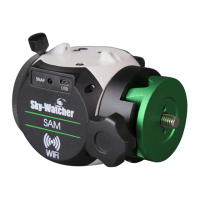Appendix II: Calibrang the Polar Scope
For the highest precision it may be necessary to align the recule in your Polar
Scope before performing a polar alignment. This simple calibraon procedure
will ensure that your polar alignments are done to the highest possible level of
precision.
First, check to see that your Polar Scope requires calibraon. It may be just ne
right out of the box, so do this simple test before aempng the calibraon
procedure:
1. With your Polar Scope mounted in SAM aim it at a distant object (prefereably
at least 100 metres away) that will not change its locaon. A street light or
distant chimney is a good choice.
2. Align the distant target with the central cross hair in the Polar Scope recule.
3. Rotate the Polar Scope 180 degrees while keeping everything else sll.
If the distant target is sll under the central cross hair, or if it has barely moved
from that point, then YOU DO NOT NEED TO CALIBRATE your polar scope.
If the distant target has “moved away” from the cross hair signicantly, then you
should align the recule to the opcal axis of your Polar Scope.
Aligning The Polar Scope Recule to the Polar Scope Opcal Axis
If a calibraon is required you will need a 1.5 mm Allen wrench to perform the
following steps. Check your local hardware store if you don’t have one on hand.
The Polar Scope recule is held in place by the three Allen screws around the
perimeter of the eyepiece. Consequently, you should not completely loosen any
of these screws as the recule will lose its support and no longer be adjustable.
If this happens you will need to unscrew the eyepiece from the polar scope,
manually centre the glass recule as best you can, then reinsert the screw that
had lost contact.
Aim your polar scope at a distant
target then rotate the Polar Scope 180
degrees so that the lock knob is on the
opposite side. Next, check the posion
of your distant target in the eyepiece.
If it has moved o centre signicantly
you will need to calibrate your polar
scope recule.
36

